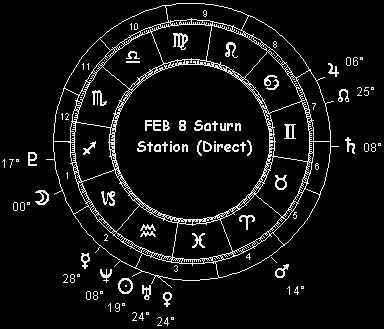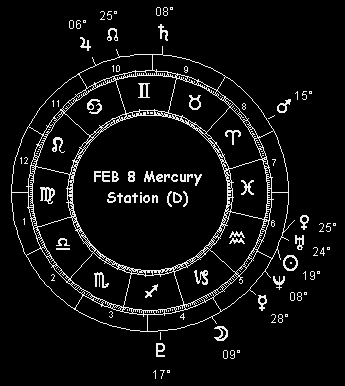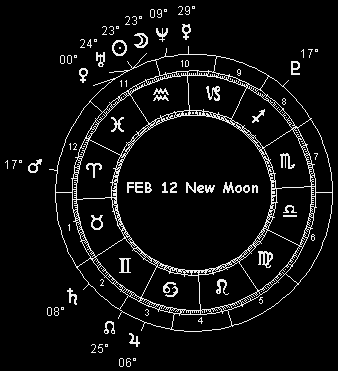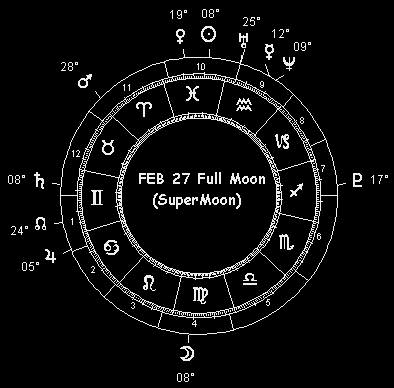If you were expecting some kind of sun sign nonsense, forget it. This is real astrology. See the section above. Please note: this forecast is expressed in terms of Universal Time (UT).
 February opens up with a mild case of geophysical jitters, what with Luna crossing the celestial equator southward on the 2nd. This signals a somewhat elevated risk for storms, flooding and seismic activity (e.g. volcanic eruptions, Richter 5 or greater quakes) from the 1st through the 3rd. There's a similar trend in effect from a day before to a day after the 8th, what with the Moon reaching its maximum southern declination on that date. So again, watch for increased weather related headlines, earthquake and volcano making the news, etc. As before, this looks like only a slight up-tick in meteorological and seismic action - higher than normal, but nowhere near in the same league as an eclipse or SuperMoon. (Don't fret, you'll get a chance to experience the latter toward the end of February.)
February opens up with a mild case of geophysical jitters, what with Luna crossing the celestial equator southward on the 2nd. This signals a somewhat elevated risk for storms, flooding and seismic activity (e.g. volcanic eruptions, Richter 5 or greater quakes) from the 1st through the 3rd. There's a similar trend in effect from a day before to a day after the 8th, what with the Moon reaching its maximum southern declination on that date. So again, watch for increased weather related headlines, earthquake and volcano making the news, etc. As before, this looks like only a slight up-tick in meteorological and seismic action - higher than normal, but nowhere near in the same league as an eclipse or SuperMoon. (Don't fret, you'll get a chance to experience the latter toward the end of February.)
 The 8th is a very busy day out in the heavens. A couple retrogrades both draw to a close that day: first Saturn stations at 8 Gemini, then Mercury follows suit at 29 Capricorn. Ironic: a mutual reception pair of stations, each planet in a sign of the other's rulership. Slow-moving Saturn began its retrograde back in September, on the 27th; and has been within a degree of its February 8 station since January 6. It won't be until next month (on the 13th) that Saturn finally moves outside a degree of its station point. So in some ways the whole of February is under the aegis of this one planetary factor. This is not a good sign for the communication and transportation industries, nor for the infrastructure that supports them. While the worst in this regard should be left behind after the 8th, what's left looks better more in relative than absolute terms.
The 8th is a very busy day out in the heavens. A couple retrogrades both draw to a close that day: first Saturn stations at 8 Gemini, then Mercury follows suit at 29 Capricorn. Ironic: a mutual reception pair of stations, each planet in a sign of the other's rulership. Slow-moving Saturn began its retrograde back in September, on the 27th; and has been within a degree of its February 8 station since January 6. It won't be until next month (on the 13th) that Saturn finally moves outside a degree of its station point. So in some ways the whole of February is under the aegis of this one planetary factor. This is not a good sign for the communication and transportation industries, nor for the infrastructure that supports them. While the worst in this regard should be left behind after the 8th, what's left looks better more in relative than absolute terms.
Mercury's retrograde means more of Murphy's Law running the show until the 8th as well. Again, this is not a happy indicator for transportation and communication: delays, miscues, accidents, bad weather, poor financial or business conditions and the like seem to conspire to screw things up when it comes to shipping, handling, and getting messages delivered and understood. If traveling or waiting for deliveries, plan on delays of one kind or another. If trying to get your point across, first tell 'em what you're gonna tell 'em, then tell it to 'em, then tell 'em what you told 'em. Take nothing for granted, trust no one! Among the communication snafus that are apt to be sprouting up like spring weeds, watch out for computer viruses, hacker attacks, and black-outs due to infrastructure damage (by weather, solar activity, human error - even sabotage). While the worst of this should be behind us by the 8th, there's a lingering shadow effect lasting until March 1 (when Mercury reaches the point where its retrograde began).
 I'm still expecting markets to remain mixed most of this month. With the Mercury and Saturn stations happening on the 8th, there's not enough certainty and confidence to sustain big momentum one way or the other. Weakness in the communication and transport sectors tends to hold them back of course, but it's more than that. While the outlook improves after the 8th, there's a heliocentric Saturn-Pluto opposition coming up in March (followed by the geocentric alignment in May): these are not positive market movers. The most likely scenario features some positive upward movement from the second half of February through about mid-March. After that, get ready for a downdraft and then a temporary recovery. As usual, mass psychology plays a major role in all this. With Mercury and Saturn stationing in mutual reception, there's a somber air about February, especially the early part of the month - a touch of melancholy, pessimism, cynicism and worry.
I'm still expecting markets to remain mixed most of this month. With the Mercury and Saturn stations happening on the 8th, there's not enough certainty and confidence to sustain big momentum one way or the other. Weakness in the communication and transport sectors tends to hold them back of course, but it's more than that. While the outlook improves after the 8th, there's a heliocentric Saturn-Pluto opposition coming up in March (followed by the geocentric alignment in May): these are not positive market movers. The most likely scenario features some positive upward movement from the second half of February through about mid-March. After that, get ready for a downdraft and then a temporary recovery. As usual, mass psychology plays a major role in all this. With Mercury and Saturn stationing in mutual reception, there's a somber air about February, especially the early part of the month - a touch of melancholy, pessimism, cynicism and worry.
 Another - somewhat stronger - risk period for storms, floods and seismic shocks comes with the new moon on the 12th. In effect from the 9th through the 15th, and extended from there through the 17th by the Moon's northward crossing of the equator (on the 16th), this appears to be a cycle more of meteorological than seismic or hydrological concern. High winds, heavy precipitation; and when the wind sets the same way as the tide - well, it's best to clear out of the way. That's not to say I'm expecting a seismic doldrums during this period; only that weather appears to outweigh quakes and volcanic action as a major threat to human safety and welfare now.
Another - somewhat stronger - risk period for storms, floods and seismic shocks comes with the new moon on the 12th. In effect from the 9th through the 15th, and extended from there through the 17th by the Moon's northward crossing of the equator (on the 16th), this appears to be a cycle more of meteorological than seismic or hydrological concern. High winds, heavy precipitation; and when the wind sets the same way as the tide - well, it's best to clear out of the way. That's not to say I'm expecting a seismic doldrums during this period; only that weather appears to outweigh quakes and volcanic action as a major threat to human safety and welfare now.
Smoother sailing should be in store after the 17th, and it ought to last until an ongoing period of turbulence which continues from the 22nd through the end of February, until about March 2 in fact. The first few days of this cycle coincide with the Moon reaching maximum northern declination on the 23rd. This merges into the year's first SuperMoon window, stretching three days either side of the full moon at 9 Virgo on the 27th. SuperMoon is a term I coined in a 1979 article for Dell's HOROSCOPE magazine. It refers to a new or full moon which occurs when the Moon is at or near perigee (closest approach to Earth). Earthquake and volcanic potential will likely reach its early peak for the year during this time. Mudslides, flooding, dam-breaks, river blockages, heavy rain and snow, avalanches: these are special risks.
Like all SuperMoons, this one ushers in a heightened worldwide potential for storms and seismic activity as usual: it's planetary in scale and scope. That said, east Africa and the Middle East in particular appear to be in the astro-locality crosshairs this time around, along with Japan, Indonesia, eastern China and northeastern India, eastern Brazil, western Alaska and the Gulf of Alaska, and the US Mississippi Valley area. If you're in (or plan to be in) one of these particular target zones during the SuperMoon window, it's not a bad idea to stay weather-wise and tuned in for breaking news.
 SPECIAL FEATURE: This month's birthdays of the famous and infamous (with astrological birth charts)
SPECIAL FEATURE: This month's birthdays of the famous and infamous (with astrological birth charts)
